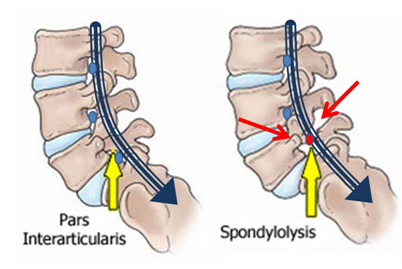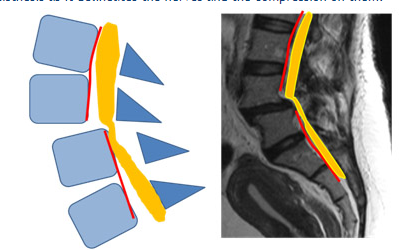Lumbar Fusion – TLIF, PLIF
- Home
- Lumbar Fusion – TLIF, PLIF
Lumbar Fusion – TLIF, PLIF
What is spondylolysis / spondylolisthesis?
Spondylolysis is a defect or fracture of part of the vertebral bone called the pars interarticularis. It usually occurs in the fifth lumbar vertebra and, less commonly, in the fourth lumbar vertebra. Spondylolisthesis is a forward slippage of one vertebral body on top of another.

Picture of Spondylolysis
What causes spondylolysis / spondylolisthesis?
The exact cause of Spondylolysis is unknown, it can be attributed to genetics, overuse activities (particularly those with hyperextension involvement such as gymnastics), and previous surgery. Spondylolisthesis occurs when there is weakening of the restraining structures of the spine. This can be due to spondylolysis, congenital factors, degeneration of the spine, trauma, and cancer.

Spondylolisthesis leads to compression of nerve roots (shown in blue colour)
What are the symptoms of spondylolysis / spondylolisthesis?
Most people with spondylolysis / spondylolisthesis are asymptomatic and are unaware they have the condition. When symptoms are present, however, they may include:
- Low back pain.
- Feeling of tightness in the back of thighs.
- Pain radiating down the legs.
- Difficulty with upright posture and gait.
Why do patients with spondylolysis / spondylolisthesis have pain?
Patients have pain in the back because of the unstable movement of the vertebra. Leg pain is caused because of pressure on the nerves.
How are spondylolysis / spondylolisthesis diagnosed?
Usually after a complete history and physical examination your doctor may be able to diagnose a spondylolisthesis. Diagnostic procedures are required to confirm the diagnosis. Diagnostic procedures for spondylolysis /spondylolisthesis may include the following:
- X-rays is the initial investigation and provides confirmation of the diagnosis as well as the probable cause. Sometimes special X-rays taken while bending forward and backward may be required for further assessment.

Slippage is evident in the radiographs
Magnetic Resonance Imaging (MRI) – MRI scan is an essential part of the investigation for spondylolisthesis as it delineates the nerves and the compression on them.

MRI shows the nerve compression
What is the treatment for Spondylolysis / spondylolisthesis?
The patient may be treated surgically or non-surgically. Treatment can only be decided after thorough examination and investigations. Every patient will have to be individually evaluated and after considering the extent of the spondylolisthesis / spondylolysis, age of the patient, a treatment protocol be decided.
What is the non-operative treatment of Spondylolysis / Spondylolisthesis?
Most patients with spondylolysis / spondylolisthesis have acute episodes of pain with intervening pain free periods. These symptoms usually improve with rest and time. To help relieve the pain, treatment may include analgesics (pain killers), belts/ braces, physiotherapy, limiting your activities.
When is surgery required?
Patients who have one or more of the following symptoms may require surgery.
- Worsening of back pain or persistent leg pain with no improvement even with adequate rest and analgesics.
- Weakness of the legs,
- Disturbance of bowel or bladder function.
- Progressive forward slipping of the vertebra.
What will be done during the surgery?
The goals of surgery are
- To prevent further slipping of the vertebra.
- To relieve the pressure on the spinal nerve.

Patient with degenerative listhesis treated by fusion surgery
What are the types of surgery for spondylolisthesis?
Posterior instrumentation and fusion- Fusion is the surgery by which the two abnormally moving vertebrae are made to join and become a single unit. Instrumentation (stabilization) is the use of metal plates, screws and rods to hold the vertebrae in position till they fuse.
Transforaminal or Posterior Lumbar Inter-body Fusion (PLIF) – In addition to posterior instrumentation and fusion, metal cages are placed in between the vertebral bodies to achieve a solid fusion.

L5 S1 listhesis treated by Fusion surgery
What is the post-operative protocol?
In most cases, patients will be ready to walk within the first few days of surgery. In more severe degrees of slips, bed rest may be required for a few weeks. Following this a physiotherapist will be there to assist you to start walking and then proceed to spine strengthening exercises. You will be instructed to follow a home program of activity and exercises and asked to come for regular follow-up.
Our institution offers comprehensive treatment for spondylolysis and spondylolisthesis. Due to our vast experience in this condition, we regularly perform the entire spectrum of spondylolisthesis surgery. We also have a fully equipped physiotherapy centre to aid in post-operative rehabilitation
Surgical Expertise
Testimonials
What Our Patients Say
EXCELLENT rating
Based on 107 reviews My father had rotator cuff problems and needed follow-up care.Dr.Ankith N V was exceptional. They provided thorough, compassionate care and clear communication. The clinic was well-equipped, and attentive Highly recommend.
My father had rotator cuff problems and needed follow-up care.Dr.Ankith N V was exceptional. They provided thorough, compassionate care and clear communication. The clinic was well-equipped, and attentive Highly recommend. RAVINDRA KUMAR2024-06-09Very good Orthopaedic Clinic and Dr Ankith sir well experienced Dr and also clear all the doubts for patients and their families...
RAVINDRA KUMAR2024-06-09Very good Orthopaedic Clinic and Dr Ankith sir well experienced Dr and also clear all the doubts for patients and their families... Dilip Gowda BR2024-05-29I had an outstanding experience with Dr. Ankit at Ankit’s Orthopedic . Dr. Ankit’s exceptional friendliness and professionalism made me feel comfortable and well-cared for throughout my visit. I highly recommend Dr. Ankit for their exemplary patient care and welcoming demeanor.
Dilip Gowda BR2024-05-29I had an outstanding experience with Dr. Ankit at Ankit’s Orthopedic . Dr. Ankit’s exceptional friendliness and professionalism made me feel comfortable and well-cared for throughout my visit. I highly recommend Dr. Ankit for their exemplary patient care and welcoming demeanor. Nikhil L2024-05-29Doctor is so knowledgeable and humble. Also he listens to us keenly and understands the problem. Highly recommended.
Nikhil L2024-05-29Doctor is so knowledgeable and humble. Also he listens to us keenly and understands the problem. Highly recommended. Akshay2024-05-29Good communicate with patients and cooperation well good, we are satisfied your treatment.
Akshay2024-05-29Good communicate with patients and cooperation well good, we are satisfied your treatment. renuka Mallikarjuna2024-05-22Best orthopaedic clinic in vijayanagar good service
renuka Mallikarjuna2024-05-22Best orthopaedic clinic in vijayanagar good service ಬಳ್ಳಾರಿ ನಾಗ2024-05-22Very good doctor and
ಬಳ್ಳಾರಿ ನಾಗ2024-05-22Very good doctor and Kiran S2024-05-18Really...this clinic is too good i recommended Dr.Ankith sir ..and doctor treat very well, he had more knowledge and as well as good human being and his staff is wonderful, this is the perfect place for orthopedic and spine
Kiran S2024-05-18Really...this clinic is too good i recommended Dr.Ankith sir ..and doctor treat very well, he had more knowledge and as well as good human being and his staff is wonderful, this is the perfect place for orthopedic and spine ashoka vc2024-05-17Good service well qualified doctor
ashoka vc2024-05-17Good service well qualified doctor srinath v2024-05-17
srinath v2024-05-17
Book Your Appointment Today!
Call us at 099644 83761 to schedule your visit. Your path to recovery begins at Dr. Ankith’s Orthopedic & Spine Care Clinic. We look forward to helping you achieve your health goals!
